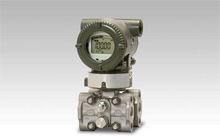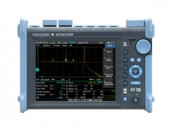 Yokogawa Electric Corporation announces that it has developed a new low-power version of the DPharp EJA-E series differential pressure/pressure transmitter and will release this product in all markets other than Japan and Europe on December 15. The European release will follow in 2015. This new low-power product outputs both 1 to 5 V DC and HART signals and has been developed to meet the specific requirements of oil and gas exploration and production (upstream) applications.
Yokogawa Electric Corporation announces that it has developed a new low-power version of the DPharp EJA-E series differential pressure/pressure transmitter and will release this product in all markets other than Japan and Europe on December 15. The European release will follow in 2015. This new low-power product outputs both 1 to 5 V DC and HART signals and has been developed to meet the specific requirements of oil and gas exploration and production (upstream) applications.
Yokogawa's differential pressure/pressure transmitters are playing a key role in achieving the objectives of the Evolution 2015 mid-term business plan, which calls for the company to focus on the booming upstream oil and gas industries, and in the implementation of a control business strategy that commits the company to capturing the No.1 position in the global sensor market. With this new low-power DPharp transmitter, Yokogawa aims to expand its control business and achieve the targets set out in its Evolution 2015 plan.
Differential pressure/pressure transmitters are widely used in the oil, petrochemical, and chemical industries to measure the pressure, flow rate, and level of liquid, gas, and steam. They can be found both in plants and in the field, at locations such as oil and gas wells. Thanks to the global rise in demand for energy, oil and gas resources are being actively developed. As technological progress in recent years has made it possible to develop and produce oil and gas in places with poor infrastructure (such as electricity and communications), instruments and devices in such areas must be able to function on a limited power supply from solar power or batteries.
Adidas Fotballsko
 National Instruments, the provider of solutions that enable engineers and scientists to solve the world’s greatest engineering challenges, today announced a compact solution for high-speed vision applications. The NI CVS-1459RT is a small, rugged vision system with a quad-core Intel Atom processor and two dedicated USB 3.0 ports for USB3 Vision cameras.
National Instruments, the provider of solutions that enable engineers and scientists to solve the world’s greatest engineering challenges, today announced a compact solution for high-speed vision applications. The NI CVS-1459RT is a small, rugged vision system with a quad-core Intel Atom processor and two dedicated USB 3.0 ports for USB3 Vision cameras. A biopharmaceuticals company needed an accurate and repeatable level measurement of caustic soda solution, which was used to control the biopharmaceutical process of continuous fermentation.
A biopharmaceuticals company needed an accurate and repeatable level measurement of caustic soda solution, which was used to control the biopharmaceutical process of continuous fermentation. Yokogawa Meters & Instruments Corporation announces that it has developed the AQ7280 series of optical time domain reflectometers (OTDRs) for the installation and maintenance of fiber-optic cables, and will release a total of nine models for this product series on September 29.
Yokogawa Meters & Instruments Corporation announces that it has developed the AQ7280 series of optical time domain reflectometers (OTDRs) for the installation and maintenance of fiber-optic cables, and will release a total of nine models for this product series on September 29. NI, the provider of solutions that enable engineers and scientists to solve the world’s greatest engineering challenges, today announced the CompactRIO performance controller. This software-designed controller integrates the latest embedded technologies from Intel and Xilinx to deliver unparalleled performance and flexibility, and is fully supported by LabVIEW 2014 and NI Linux Real-Time. It is ideal for advanced control and applications in harsh, industrial environments and provides high-performance processing, custom timing and triggering, and data transfer from modular C Series I/O.
NI, the provider of solutions that enable engineers and scientists to solve the world’s greatest engineering challenges, today announced the CompactRIO performance controller. This software-designed controller integrates the latest embedded technologies from Intel and Xilinx to deliver unparalleled performance and flexibility, and is fully supported by LabVIEW 2014 and NI Linux Real-Time. It is ideal for advanced control and applications in harsh, industrial environments and provides high-performance processing, custom timing and triggering, and data transfer from modular C Series I/O.